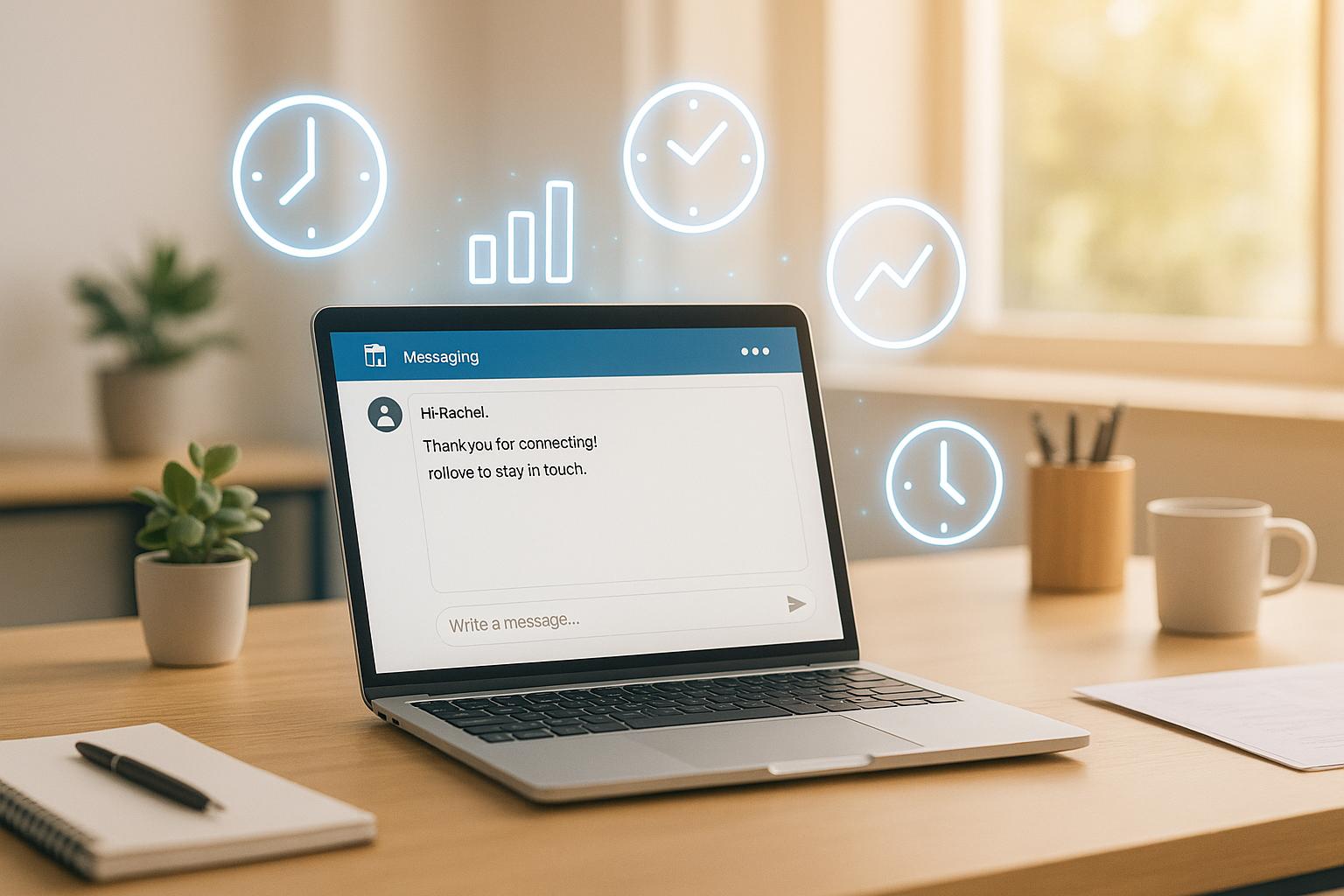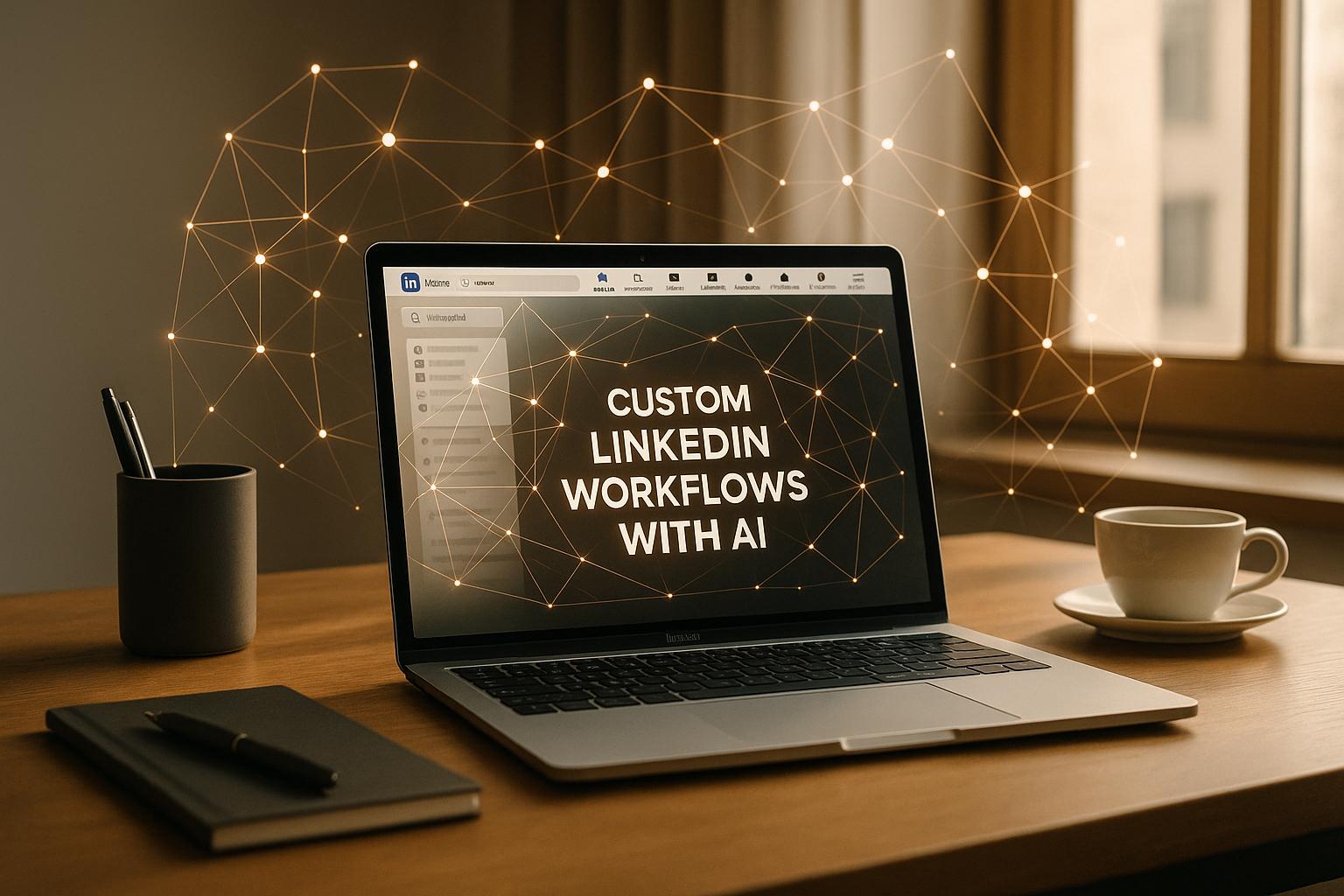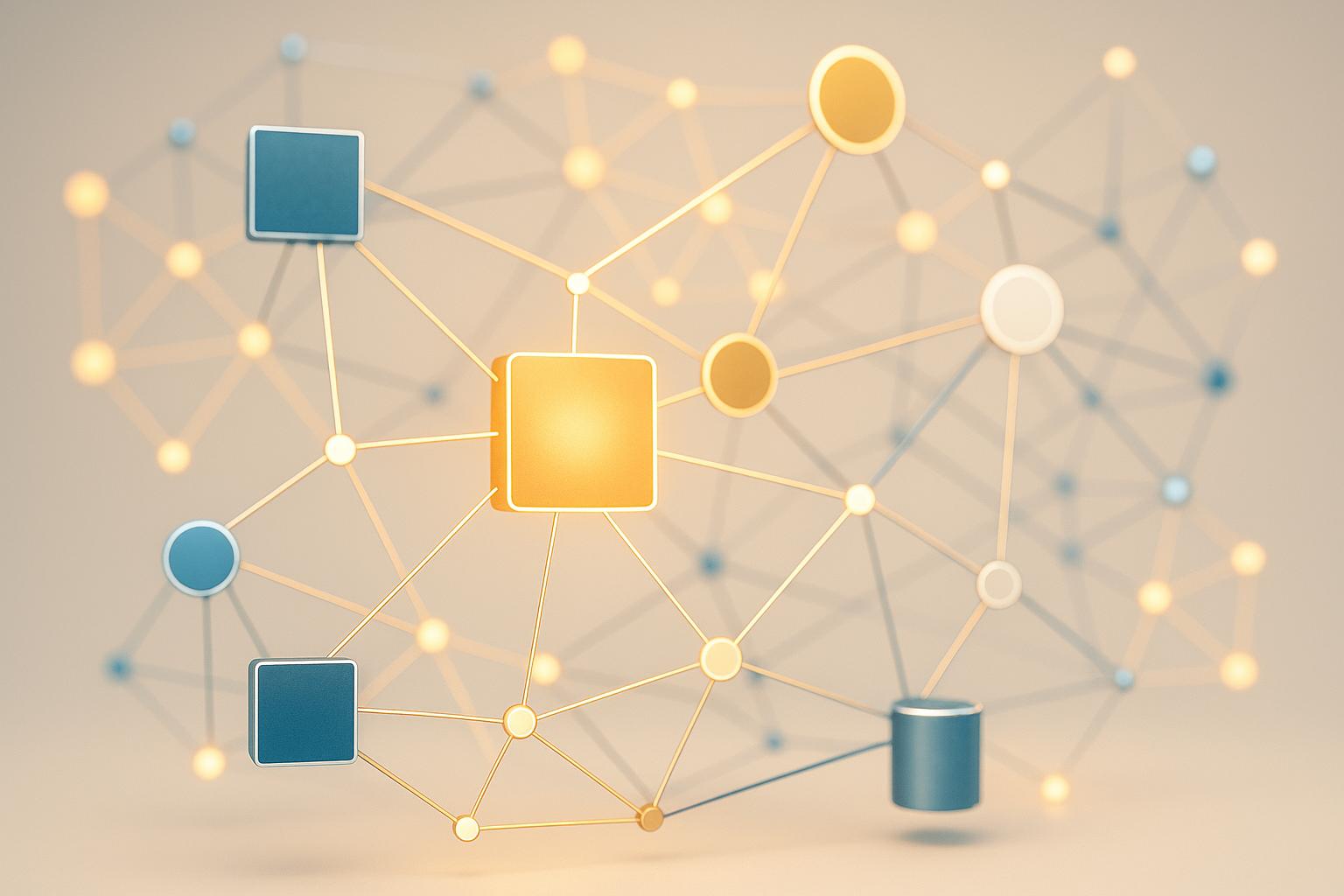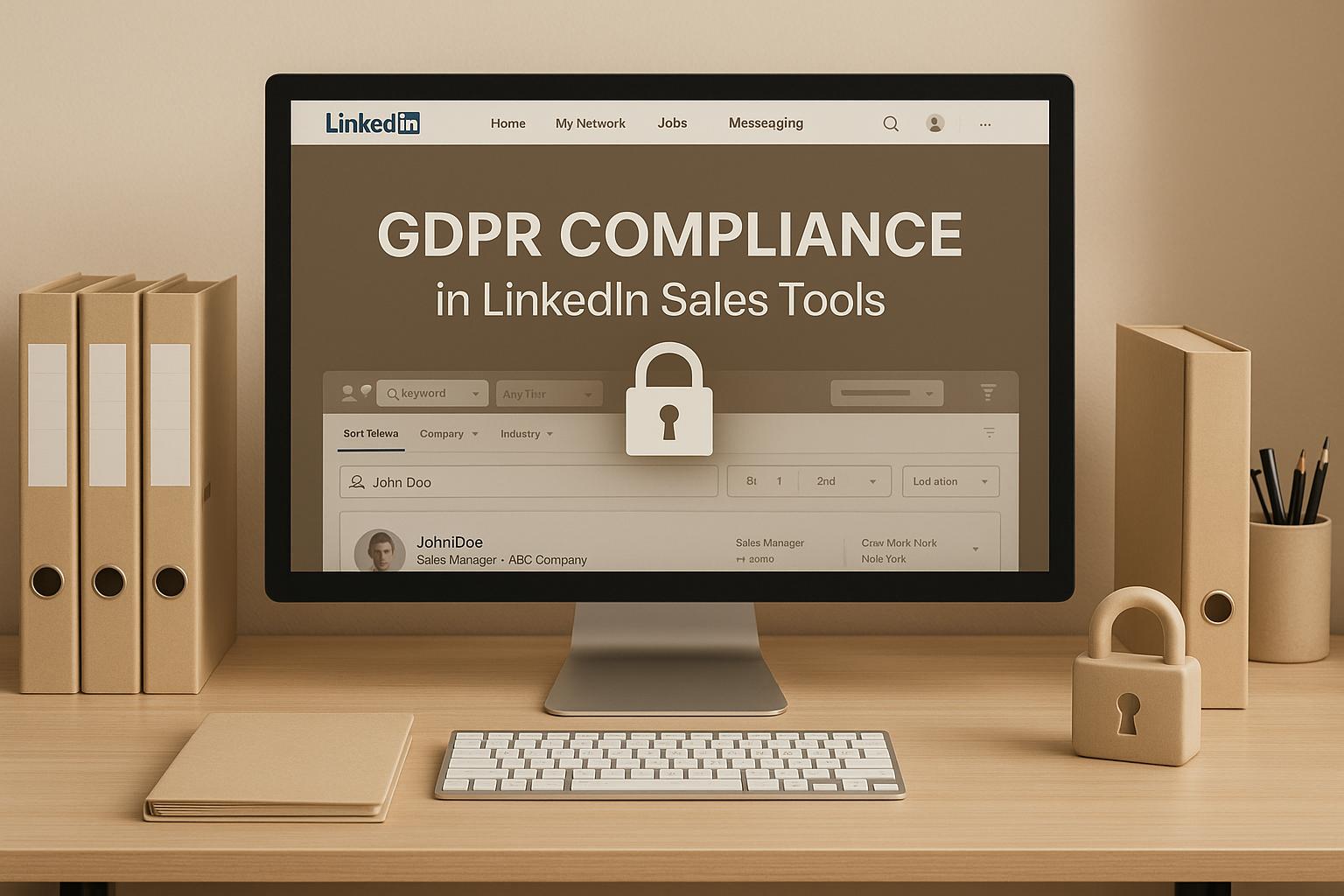
.avif)
Julien Gadea
Julien Gadea specializes in AI prospecting solutions for business growth. Empowering businesses to connect with their audience with SalesMind AI tools that automate your sales funnel, starting from lead generation.
AI makes LinkedIn follow-ups more effective by analyzing data to send messages at the perfect time. Poorly timed follow-ups often get ignored, but AI fixes this by studying user behavior, time zones, and industry trends to ensure messages arrive when prospects are most likely to respond. It personalizes timing for each prospect, tracks engagement, and adjusts strategies based on real-time feedback. This reduces errors, saves time, and increases response rates.
Key takeaways:
- AI analyzes LinkedIn activity to identify optimal outreach times.
- It customizes follow-up schedules based on individual behaviors and engagement patterns.
- AI automates timing, eliminates manual errors, and improves follow-up consistency.
- Tools like SalesMind AI combine timing insights with lead scoring to focus on high-priority prospects.
This LinkedIn Message Gets 30% Response Rates & Prints Money
How AI Optimizes Follow-Up Timing
AI transforms follow-up timing into a precise, data-driven process by analyzing massive amounts of prospect activity. Instead of relying on guesswork, it evaluates detailed data to figure out the best times to reach out, ensuring your messages land when prospects are most likely to engage.
Data Analysis for Better Timing
AI gathers and examines data to pinpoint the ideal moments for engagement. For example, it tracks LinkedIn activity patterns, such as when users log in, read messages, or interact with content. It also studies past response times to identify peak engagement windows.
Beyond general activity, AI dives into industry-specific trends. For instance, it might reveal that CFOs in healthcare often respond to messages on Tuesday mornings between 9:00 AM and 11:00 AM EST, while tech marketing directors are more active on Thursday afternoons. This level of detail allows for highly targeted outreach.
AI also accounts for time zones, ensuring messages are sent at appropriate local times. This feature prevents common mistakes like sending messages that get buried in overnight notifications, increasing the likelihood of a timely response. Additionally, it adjusts to seasonal and industry trends, keeping timing relevant and effective.
Building on these broader insights, AI takes personalization a step further by tailoring timing to each individual prospect.
Custom Timing Based on User Behavior
AI develops personalized timing profiles for each prospect by analyzing their specific behaviors. It tracks when prospects open and engage with messages, using this data to fine-tune future follow-ups.
For example, if a prospect regularly opens educational content on Wednesday mornings but responds to direct sales messages on Friday afternoons, AI adjusts the schedule accordingly. This ensures that each type of message reaches the prospect when they’re most likely to engage.
AI also analyzes response speed to determine the best follow-up intervals. Some prospects reply within hours, while others take days to consider a proposal. By recognizing these patterns, AI prevents follow-ups that feel too pushy or delayed, keeping the interaction natural and productive.
The system monitors engagement signals like profile visits, content downloads, or website activity following a LinkedIn message. These insights help AI distinguish between prospects who are actively evaluating your offer and those who are simply being polite. This distinction allows for more strategic and well-timed follow-ups.
All these personalized adjustments contribute to a system that’s constantly learning and improving.
Learning and Adapting Over Time
AI doesn’t just stick with what works; it evolves. Each campaign provides new data that refines its timing recommendations. For example, if a follow-up sent at a suggested time gets a positive response, the system strengthens that timing pattern. If a message goes unanswered, the AI learns to avoid similar time slots in the future.
It also adapts to changing behaviors. If work-from-home policies lead to prospects checking LinkedIn later in the day, AI detects this shift and updates its recommendations. This flexibility ensures your follow-up timing stays aligned with current trends.
Campaign performance feedback plays a key role in this learning process. AI evaluates which timing strategies lead to higher response rates, shorter sales cycles, and better conversions. This allows it to focus on timing factors that drive real results, rather than just surface-level engagement.
AI even learns from negative signals, such as unsubscribe requests or "not interested" responses. It identifies timing patterns that might contribute to prospect fatigue and adjusts future campaigns to avoid these pitfalls. This helps maintain your sender reputation and keeps prospects open to future outreach.
Finally, AI applies cross-campaign insights to accelerate optimization. Successful timing strategies from one industry or prospect type are applied to similar segments, uncovering opportunities that might not be obvious with smaller data sets. This knowledge-sharing approach ensures your campaigns benefit from the broader learning of the system.
Personalization and Lead Prioritization with AI
AI is revolutionizing follow-up strategies by blending deep personalization with smart lead prioritization. It turns generic outreach into tailored, meaningful interactions that connect with prospects on a personal level. At the same time, it ensures sales teams focus their energy on leads most likely to convert.
Customizing Follow-Ups at Scale
AI takes follow-up messaging to the next level by pulling data from various sources to craft messages that feel personal and relevant. It taps into LinkedIn profiles, company updates, industry news, and even recent social media activity to identify triggers like job changes, funding announcements, or expansions. These insights allow AI to craft messages that resonate with prospects' current needs and interests.
For example, if a prospect recently shared an article about digital transformation challenges, AI can weave this into the follow-up, referencing their interest and linking it to your solution. Similarly, AI automatically adapts messaging to fit different industries. A healthcare CTO might receive a message highlighting compliance and security, while a retail marketing director would see a focus on customer acquisition and seasonal trends. This approach eliminates the generic, one-size-fits-all strategy and significantly improves response rates.
AI also fine-tunes the tone and style of communication based on a prospect's behavior and role. Executives often prefer concise, results-driven messages, while mid-level managers might engage more with detailed explanations or case studies. By learning from past interactions, AI applies these preferences to similar prospects, making each message more effective.
Beyond individual messages, AI tracks the performance of entire follow-up sequences. If a prospect opens but doesn’t respond to a product-focused email, the next follow-up might pivot to educational content or industry insights to keep the conversation alive. This dynamic approach ensures every touchpoint is relevant and engaging.
Once messages are personalized, AI shifts focus to prioritization, helping sales teams zero in on the most promising leads.
Lead Scoring to Focus on Top Prospects
Lead scoring is where AI truly shines, assigning scores to prospects based on their likelihood to convert. This scoring system helps sales teams avoid wasting time on low-potential leads and focus on high-value opportunities.
AI evaluates leads using a mix of engagement signals and profile data. Actions like viewing your profile, opening messages, or interacting with content add points to a prospect’s score. Meanwhile, factors like company size, industry, and growth stage are weighed against your ideal customer profile. Recent activities - like job postings, funding rounds, or adopting new technologies - can also boost a prospect’s score, signaling a higher likelihood of conversion.
Behavioral patterns play a big role, too. For instance, prospects who quickly respond to outreach, visit your website after receiving a LinkedIn message, or engage repeatedly with your content are flagged as high-priority. AI even takes timing into account, giving higher scores to prospects researching solutions during budget planning periods or renewal cycles. This ensures follow-ups are timed to align with their buying process.
On the flip side, AI uses negative scoring to deprioritize leads. Prospects who ignore messages, hold irrelevant job titles, or work at companies outside your target audience are given lower scores, helping sales teams avoid chasing unlikely opportunities.
SalesMind AI in Action

SalesMind AI combines personalized messaging and advanced lead scoring to streamline LinkedIn outreach. Its AI-powered unified inbox consolidates all conversations, automatically scoring and prioritizing prospects based on their likelihood to engage.
The platform’s lead scoring system evaluates prospects using a wide range of data points, such as profile completeness, company growth, and engagement history. This ensures sales teams focus on the leads most likely to convert.
SalesMind AI also excels at automated personalized messaging. It doesn’t just insert names - it analyzes profiles, activities, and industry trends to create messages that feel authentic and relevant. This level of personalization scales effortlessly across hundreds of prospects without sacrificing quality.
With integrated LinkedIn access, SalesMind AI puts everything - personalization data, lead scores, and timing recommendations - right at your fingertips within the LinkedIn interface. No need to juggle multiple tools or platforms.
The platform’s real-time lead tracking ensures you never miss a hot lead. If a high-priority prospect downloads a whitepaper or visits your pricing page, SalesMind AI flags them instantly, prompting immediate follow-up. This ensures your team stays on top of every opportunity, maximizing conversions.
sbb-itb-817c6a5
Automating Multi-Step Follow-Up Sequences
Building on personalized messaging and targeted lead scoring, AI-powered follow-up sequences now ensure your outreach stays relevant and responsive. By using data-driven insights, these sequences align perfectly with the tailored strategies discussed earlier.
AI takes follow-up workflows to the next level by making them adaptable to each prospect's behavior. Instead of sending out the same messages to everyone, AI crafts dynamic pathways that respond to how prospects interact with your outreach.
Traditional follow-up sequences are rigid: send one message on day one, another on day three, and so on, regardless of what happens in between. AI disrupts this outdated approach by monitoring every interaction and adjusting the sequence in real time. It tracks a wide range of engagement signals, like when prospects are most active on LinkedIn, typical response times, or even seasonal trends. For instance, someone in retail might be less responsive during Black Friday, so AI spaces out follow-ups during busy periods and increases frequency when things calm down.
The real power of AI lies in its ability to adapt and branch. Instead of a one-size-fits-all sequence, AI creates decision trees where each prospect’s journey changes based on their actions. For example, a prospect who downloads a resource might receive educational content next, while someone who visits your pricing page gets a sales-focused message. This creates dozens of potential pathways within a single campaign, each tailored to different levels of interest and engagement.
Dynamic Scheduling for Follow-Ups
AI doesn’t just schedule follow-ups; it fine-tunes the timing for maximum impact. It analyzes optimal sending times for each prospect based on their LinkedIn habits, industry norms, and past responses. Some people check LinkedIn early in the morning, while others are more active during lunch breaks or evenings.
It also picks up on contextual signals. If a prospect posts about a challenge your solution can solve, AI can trigger an immediate, relevant follow-up instead of waiting for the next scheduled message. Similarly, if someone shares news about company growth or funding, the system fast-tracks a follow-up focused on scaling solutions.
Another key feature is pause and resume functionality. If a prospect responds to a message, AI automatically pauses the sequence. When the conversation cools off, it resumes with contextually appropriate follow-ups that acknowledge previous interactions.
AI also adjusts timing based on the content and the recipient’s seniority. For instance, a C-level executive might receive follow-ups spaced 5-7 days apart to avoid being overly persistent, while a mid-level manager might see 3-4 day intervals. Educational content might have shorter delays, while direct sales pitches have longer gaps to give prospects time to process the information.
Seasonal and industry-specific timing adds even more precision. AI knows that accountants are swamped during tax season, retailers are busy during the holidays, and many industries slow down in late December. It adjusts follow-up schedules to avoid these hectic periods and focus on more receptive times.
This dynamic scheduling approach stands in stark contrast to static, manual methods, as shown below.
Manual vs. AI-Driven Follow-Ups
Here’s how manual and AI-driven follow-ups compare:
| Aspect | Manual Follow-Ups | AI-Driven Follow-Ups |
|---|---|---|
| Consistency | Prone to human error and delays | Precise, automated scheduling based on optimal times |
| Personalization Scale | Limited by time and manual effort | Scalable personalization for hundreds of prospects |
| Behavioral Response | Requires manual monitoring | Automatically adapts based on prospect actions |
| Sequence Management | Fixed, hard-to-adjust sequences | Dynamic branching that evolves with engagement |
| Performance Tracking | Manual data collection and analysis | Real-time analytics and optimization suggestions |
| Resource Requirements | High time investment per prospect | Minimal ongoing effort required |
| Response to Engagement | Risk of sending messages after replies | Automatically pauses/resumes based on responses |
| Optimization | Relies on intuition and limited testing | Continuous A/B testing and data-driven improvements |
Manual follow-ups work well in highly relationship-driven sales where deep personal knowledge is essential. They’re ideal for small prospect lists where sales reps can dedicate significant time to each lead. However, they often fall short in consistency, leading to missed opportunities and poorly timed messages.
AI-driven systems excel in scaling efforts while maintaining personalization. They never miss a follow-up, always send messages at the right times, and learn from every interaction. That said, they may struggle with situations requiring deep emotional intelligence or complex relationship dynamics.
SalesMind AI bridges this gap by combining automation with human oversight. Sales teams can review and approve sequences before launching, make on-the-fly adjustments, and step in for high-value leads needing a personal touch. The unified inbox ensures that when a prospect responds, sales reps can seamlessly take over with full context of previous automated interactions.
Measuring and Improving Follow-Up Performance
Once you've set up personalized messaging and dynamic follow-ups, the next step is figuring out what’s working and what isn’t. This is where tracking performance through data-driven insights becomes essential. With AI-powered follow-ups, you can rely on analytics to refine your approach.
The key is to focus on metrics that matter and use those numbers to adjust your timing, messaging, and sequence strategies. Instead of guessing, you’re making decisions based on how prospects actually behave.
Key Metrics for Follow-Up Success
To measure success, keep an eye on these metrics:
- Response rates: This is your go-to metric for gauging how effective your follow-ups are. It shows the percentage of prospects who respond at each stage of your outreach.
- Connection acceptance rates: Tracks how many people accept your LinkedIn connection requests, giving you a sense of how well you’re expanding your network.
- Engagement depth: Goes beyond simple replies to measure the quality of interactions. Are prospects just replying with a quick “thanks,” or are they engaging in meaningful conversations?
- Conversion rates: Measures how many prospects move from initial contact to key actions like scheduling a call or requesting a demo. AI can break this down by sequence type, timing, and prospect demographics to highlight what’s working.
- Time-to-response: Looks at how quickly prospects reply, helping you fine-tune the timing of your messages.
- Sequence completion rates: Tracks how many prospects make it through your entire follow-up sequence versus those who drop off, pinpointing areas that might need tweaking.
- Cost per qualified lead: This metric weighs your outreach investment against the results, factoring in time saved through automation and better conversion rates.
AI-Driven Insights for Better Results
AI doesn’t just collect metrics - it turns them into actionable insights. For example, it might reveal that prospects who engage with your content before receiving follow-ups are more likely to respond positively. AI can also identify the best times to send messages and the types of messaging that resonate most.
What’s more, AI provides real-time suggestions for improvement. If your response rates start to dip, it can flag potential problems and recommend changes to your timing, messaging, or targeting strategies. By using cohort analysis, AI can segment prospects by factors like industry, company size, job role, or engagement history, helping you tailor your approach to different groups.
AI can even analyze the sentiment of prospect replies, giving you a sense of their interest level or emotional tone. This allows you to adjust your follow-ups to match their mood and preferences. Tools like SalesMind AI consolidate all these insights into a single dashboard, making it easy for sales teams to identify which sequences are performing well and where there’s room for improvement.
These insights naturally set the stage for effective A/B testing.
A/B Testing for Better Performance
A/B testing, powered by AI, simplifies the process of optimizing your follow-ups. It allows you to run experiments across different segments of your audience to see what works best.
For example, you could test variations in:
- Message content: Try different subject lines, opening lines, calls-to-action, or even message lengths to see which versions get the most engagement.
- Timing: Experiment with different send times and intervals between messages to find the sweet spot for higher response rates.
- Sequence structure: Test different flows - like the number of follow-ups or the tone of your messages - to see which approach generates better results.
You can also test how much personalization works best or explore the impact of combining multiple channels, such as pairing LinkedIn outreach with email follow-ups. AI runs these tests in the background, continuously analyzing results and making small adjustments over time. This constant fine-tuning ensures your follow-up strategy stays in sync with changing prospect preferences and market trends.
The Future of AI in LinkedIn Outreach
AI-powered LinkedIn outreach has become the go-to strategy for competitive sales teams. This shift builds on earlier improvements in timing and personalization, pushing the boundaries of what’s possible in digital prospecting.
AI tools are advancing rapidly, learning to interpret prospect behavior, predict the best times to reach out, and craft personalized messages. This isn’t just about automation anymore - it’s about intelligence that adapts and evolves with every interaction.
Key Takeaways
AI is revolutionizing LinkedIn outreach by replacing educated guesses with data-driven precision. Instead of relying on generic schedules, AI studies behavior patterns to pinpoint when prospects are most likely to engage. The result? Higher response rates and more productive conversations.
Performance tracking has also taken a leap forward. AI doesn’t just stop at surface-level metrics like open rates. It dives deeper, identifying trends in prospect behavior, predicting which leads have the highest likelihood of converting, and offering actionable suggestions to refine strategies. This constant learning means smarter outreach without adding to the workload.
Another game-changer? Time savings. Sales teams can spend their energy on meaningful conversations with qualified leads rather than getting bogged down scheduling follow-ups or writing individual messages. AI takes care of the repetitive tasks, freeing up humans to focus on building relationships and closing deals.
What's Next
The future of AI in LinkedIn outreach promises even more advanced capabilities. AI is heading toward a deeper understanding of context - being able to detect when a prospect’s company is undergoing a restructuring, launching a new product, or dealing with specific industry challenges.
Predictive analytics will also become sharper. AI won’t just predict the best time for a follow-up; it will tailor messages based on what has worked with similar prospects. This means more personalized communication, better conversion rates, and smarter allocation of sales resources.
As these tools evolve, they’ll incorporate even richer contextual insights. What’s exciting is how accessible this technology is becoming. Features that once demanded hefty budgets and technical know-how are now within reach for small and medium-sized businesses, making AI-powered outreach as straightforward as setting up an email campaign.
Sales teams that adopt these tools today will gain a clear advantage. They’ll expand their networks, connect with more qualified leads, and close deals faster than teams stuck in manual outreach methods. The real question isn’t whether AI will reshape LinkedIn outreach - it’s whether your team is ready to take full advantage of it.
FAQs
How does AI choose the best time to send LinkedIn follow-up messages?
AI helps pinpoint the ideal timing for sending LinkedIn follow-up messages by studying patterns in recipient activity, response habits, and even time zones. Using this information, it predicts when prospects are most likely to respond, often focusing on times like mid-morning or early afternoon to boost engagement rates.
It also ensures follow-ups are sent within a well-timed window - typically 3 to 5 days after the initial message. This approach strikes a balance between being persistent and respecting the recipient’s schedule, increasing the chances of a successful outreach.
How does AI determine the best time to follow up with LinkedIn prospects?
AI uses a mix of data points to determine the best time to follow up with each prospect. It looks at things like engagement patterns, recent LinkedIn activity, past interactions, and behavioral trends to predict when someone is most likely to respond.
By aligning follow-up timing with a prospect's unique habits and preferences, AI boosts response rates and creates opportunities for deeper, more meaningful connections - making your outreach both smarter and more productive.
How does AI adjust follow-up timing to match prospect behavior and market trends?
AI takes the guesswork out of follow-up timing by analyzing factors such as email open rates, LinkedIn activity, and past interactions. By pinpointing the moments when prospects are most likely to respond, it ensures your outreach lands at just the right time.
Beyond timing, AI keeps an eye on market trends, tweaking messaging to stay relevant and aligned with current events. This flexible approach not only boosts response rates but also keeps your LinkedIn outreach campaigns tailored and engaging.




